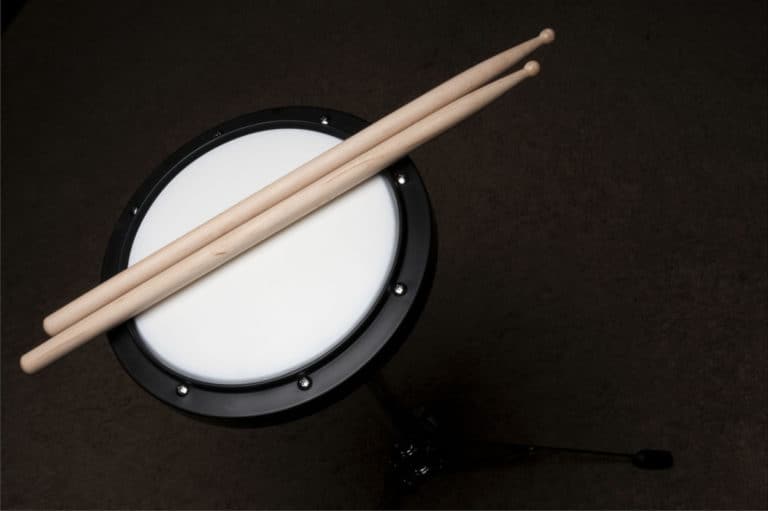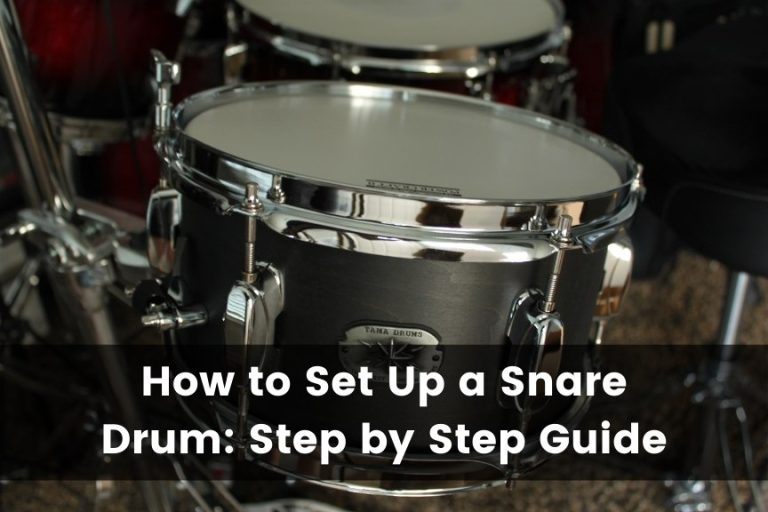How To Connect Electronic Drums To A Computer
You may think connecting an electronic drum set to a computer is a complicated process, but it is relatively straightforward if you know how to go about it. For your benefit, we have listed a step-by-step guide to making your connecting process that much easier.
We will discuss everything from connecting your drums to the computer to how to record your drums. Find out how to connect your electronic drums to a computer by reading on.
1. Update Drum Module Driver Before Connecting
To ensure we don’t run into any snags or problems down the line, we need to ensure that our drum module has the most recent firmware and driver update. The driver allows our electronic drum kit to communicate with our computer. Without this, the computer can not recognize the drum kit.
It is also essential to install the most recent driver and firmware software for your operating system since they may contain critical updates such as bug fixes and functionality improvements. An extra plus is that you may even get some free samples out of these updates.
It goes without saying that if you had recently purchased your electronic drum kit, the new driver updates might already be pre-installed. However, it is still best to check online if there are any updates. Please note: some drum modules do not require special driver installations or configurations as it automatically connects to your computer.
If you need to install a driver for your drum module, follow the steps below;
- Visit the official website of the electronic drum kit manufacturer.
- Navigate to the drum module’s driver installation page.
- Find your drum kit model and the latest driver and firmware update for your operating system. It may be somewhat tricky to find the installation page for your drum module’s driver on the manufacturer’s website. If you are having trouble, type in the manufacturer’s name + the kit’s model + driver update in the search bar.
- When the file has been downloaded, find the relevant file in the Downloads folder, and launch the installer file. If the file was delivered as a .zip file, right-click and select ‘extract all’ for PC. On a Mac, the file may have already been decompressed automatically.
If it has not been decompressed, double click the file, and a new folder with its contents should appear next to it. If that doesn’t work, right-click and select ‘open with’ then click ‘Archive Utility.’ Once the file has been extracted, launch the installer and follow the instructions.
2. Connect The Drum Module To The Computer
Next, we need to connect the drum module to our computer. Thankfully, there are various ways to do this, so choose the method that best suits you. Below we will discuss three ways to connect your drum module to the computer.
The three methods involve using either a USB cable, an audio interface, or a MIDI interface. So what is the difference? Let’s look at these different methods in a little more detail.
Connect Via USB
The simplest and most common way to connect your electronic drum kit to your computer is via a USB cable. Today, even many entry-level electronic drum kits come with USB ports. However, not all kits come with USB ports, especially older drum kit models, so make sure to check if your drum kit supports USB.
If it does, you’re in luck because you simply need to connect one cable to the computer – easy. Connecting your electronic drum kit to your computer via USB will allow audio channels to be sent and received on the same cable.
The number of channels can range from two separate audio channels (left and right) to 32-channels depending on your drum module. Upon connecting the drum module to the computer via USB cable, the computer should recognize the drum module as an audio device (sound card).
To check if your computer recognizes the module, open the audio settings of your computer or laptop. You should find the drum module listed as an audio device. You should also see how many in/out channels your module has on the same page.
Connect Via Computer Input Jack
We can use a basic recording method if you do not have USB audio. Unfortunately, only those with desktop computers can use this method as we would need to connect our module to the input jack of our desktop computer. However, if your laptop happens to have an input jack, we can also use it.
We can connect a jack cable from the headphones out port of the module and the other end into the mic input of our computer. Alternatively, we can connect a splitter cable from the master outs (left and right) and the other end into the mic input of our computer.
Connect Via Audio Interface
If your electronic drum kit does not have USB capabilities, you will need to look for other means of connection, such as via an audio interface. To start, connect the audio interface to the computer via USB. Next, connect the master left and right outputs of the drum module to channels one and two of the audio interface.
If your drum module has ‘direct outputs,’ you can use them to transfer audio signals of different drum elements, such as kick, toms, and snares. However, it is essential to ensure that your audio interface has enough inputs if you intend to transfer audio signals of individual drum parts.
Connect Via MIDI Interface
Additionally, you can connect your drum module to the computer using a MIDI interface. Connect the MIDI cable to the MIDI Out-port of the module and the MIDI In-port of the interface. With MIDI, we can use the electronic drum kit as a trigger for samples on our DAW or standalone VST.
A MIDI interface isn’t the only way to receive and send MIDI signals; if your module has a USB port, the USB can also send MIDI data in addition to audio data. It might be interesting to note that MIDI has many benefits that we would not necessarily be able to achieve with audio.
It can also be advantageous to record both MIDI and audio simultaneously, as this will allow you to keep the MIDI as a backup in case you need to make edits or want to change the sound sample later stage.
3. Configure The Input Settings In The DAW
Once our module has been connected to the DAW via USB or an interface, we need to configure the DAW’s settings to recognize the drum module. For example, if you have used a MIDI interface or desire to use MIDI from your USB, we need to configure the DAW’s MIDI settings.
If you used a USB, navigate to your DAW’s MIDI settings and enable the drum module as the MIDI Input and Output ports. If you used an interface, navigate to the same MIDI settings page and enable the MIDI Input and Output ports of the interface.
If you used an audio interface, go to your DAW’s general settings and then ‘Preferences.’ You should find a page within the preference panel that looks similar to the operating system’s sound settings.
In other words, the page should display and let you select your DAW’s input and output devices. Once at that page, make sure to choose your audio interface as the sound input. If you connected your drum module via the computer input jack, open ‘preferences’ and choose the microphone jack as the sound input.
If you do not see the drum module or interface, check to see if the drivers and firmware are up to date, as this can lead to it not working correctly. Also, be sure to double-check that everything is connected correctly.
4. Check If The Drum Kit Is Showing On The Meter
Once you have configured your DAW settings to communicate with the interface or drum module, hit a drum pad to see if it shows on the output meter. If it does not show, it means that the drum is not triggering as it should. Double-check that the cables are connected correctly and that your settings have been configured properly.
5. Create Tracks In The DAW
Now it’s time to set up some tracks in the DAW to record our drums. First, let’s start on how to set up a track for MIDI. MIDI has many benefits, such as rearranging the notes and quantizing. To record MIDI, we have to either use a MIDI track (that is routed) or an Instrument track.
If you create a MIDI track, you may notice that the meter moves if you hit a drum pad, but there is no sound. Do not worry about this. MIDI tracks do not produce sound; therefore, we first have to route our track to an instrument track in order to make a sound.
Once the tracks have been created, update the track so that the module is assigned as the input and the virtual instrument is designated as the output. For audio tracks, we will need to create a stereo audio channel and select the input as channels 1 and 2 (or whatever channels match your interface’s inputs).
If you used the mic input, we would need to create a mono channel. Unfortunately, using a mic input means our tracks would lose the left and right separation in our mix. Once the mono channel has been created, select the input as channel 1. Your tracks should now be ready to record.
6. Test Gain Levels
Hit the pads of the drums to test the gain levels. The goal is to make sure that the drum output is not too loud or too soft as the output will affect the recording. We want to avoid any clipping of the audio, so test the loudest parts of the song before recording. You don’t want to find out that the recording levels have ruined your perfect take.
7. Arm the Track
Once finished, arm the track. This means that the software is ready to record. If the track is not armed, the DAW will not record any input. To arm a track, press the record button or record-enable button.
The button usually flashes to indicate that the track is armed. Please note that this process is not identical for every DAW. Therefore, be sure to familiarize yourself with how to record-enable on your DAW.
8. Record The Track
Once the track is record-enabled, we can record. Press the record button, play your instrument, and the track should start recording. Depending on which types of tracks were created, you should now be able to see your recorded piece in MIDI or audio format (or even both), depending on which types of tracks were created.
9. Edit the drums
Even though everyone has a preference regarding when to edit their drums, editing after recording can make a big difference. For instance, if you notice timing errors, you can quantize MIDI to correct the timing quickly. However, many people prefer to leave EQing and other more nuanced edits for when all the tracks of the song are finished.
Conclusion
In order to prevent any potential issues, we must first ensure that our drum module drivers and firmware are up-to-date. Then, depending on our means or what type of sound we want to record, we need to connect our module to the computer.
This can be accomplished by using a USB cable, via the mic input of the desktop, or via an audio or MIDI interface. Next, we need to ensure that the DAW recognizes our drum module or interface by configuring the input and output settings. Afterward, check the meter to see if the DAW is picking up the output from the drums.
We then need to create our tracks in preparation for recording. These tracks can either be audio, MIDI, or mono, depending on how your drum module was connected. Our final few steps are to test the gain levels and arm the track. Once finished, press the record button, and your DAW should record the output of your electronic drums. Edit the drums as desired.







